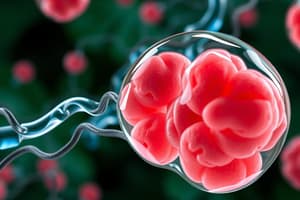Podcast
Questions and Answers
What two ways is oxygen transported in the blood?
What two ways is oxygen transported in the blood?
Dissolved oxygen in blood plasma, and bound to the hemoglobin
At normal body temperature, how much O2 will dissolve in each 100 mL of blood for every 1 mm Hg of PO2?
At normal body temperature, how much O2 will dissolve in each 100 mL of blood for every 1 mm Hg of PO2?
0.003 mL
What is the normal hemoglobin value in men?
What is the normal hemoglobin value in men?
14 to 16 g/dL
What is the normal hemoglobin value in women?
What is the normal hemoglobin value in women?
What is the normal hemoglobin value in infants?
What is the normal hemoglobin value in infants?
Each g% of Hb is capable of carrying approximately how much O2?
Each g% of Hb is capable of carrying approximately how much O2?
What is oxygen bound to hemoglobin expressed as?
What is oxygen bound to hemoglobin expressed as?
What are the two normal physiologic shunts?
What are the two normal physiologic shunts?
The total oxygen content can be calculated in which types of blood?
The total oxygen content can be calculated in which types of blood?
What does the oxygen dissociation curve illustrate?
What does the oxygen dissociation curve illustrate?
What are the two categories of oxygen transport studies?
What are the two categories of oxygen transport studies?
What is the arterial oxygen tension (PaO2)?
What is the arterial oxygen tension (PaO2)?
What is the normal range for P(A-a) O2 on room air at sea level?
What is the normal range for P(A-a) O2 on room air at sea level?
What is the normal range for the arterial alveolar pressure ratio (PaO2/PAO2)?
What is the normal range for the arterial alveolar pressure ratio (PaO2/PAO2)?
What is the amount of oxygen delivered to peripheral tissue cells normally?
What is the amount of oxygen delivered to peripheral tissue cells normally?
The difference between the CaO2 and the CvO2 is normally about how much?
The difference between the CaO2 and the CvO2 is normally about how much?
What is hypoxemia?
What is hypoxemia?
What is hypoxia?
What is hypoxia?
What is cor pulmonale?
What is cor pulmonale?
What are the three major causes of cor pulmonale?
What are the three major causes of cor pulmonale?
Flashcards are hidden until you start studying
Study Notes
Oxygen Transport in Blood
- Oxygen is transported in blood either dissolved in plasma or bound to hemoglobin.
- At normal body temperature, each 100 mL of blood dissolves 0.003 mL of O2 for every 1 mm Hg of PO2, clinically noted as 0.3 mL/dL.
Hemoglobin Values
- Normal hemoglobin values:
- Men: 14 to 16 g/dL
- Women: 12 to 15 g/dL
- Infants: 14 to 20 g/dL
- Each gram of hemoglobin can carry approximately 1.34 mL of O2.
Oxygen Content and Indices
- Total oxygen content is calculated in arterial, venous, and pulmonary capillary blood.
- Oxygenation indices can be categorized into oxygen tension-based and saturation-content-based indices.
Arterial Oxygen Tension (PaO2)
- PaO2 is a reliable indicator of oxygenation status but may be misleading in cases of low hemoglobin, decreased cardiac output, peripheral shunting, or carbon monoxide exposure.
- Alveolar-arterial oxygen tension difference (P(A-a)O2) typically ranges from 7-15 mm Hg on room air and should not exceed 30 mm Hg.
Conditions Affecting Oxygen Values
- P(A-a)O2 increases with oxygen diffusion disorders, V/Q mismatching, right-to-left shunting, and aging.
- The arterial-alveolar oxygen pressure ratio (PaO2/PAO2) indicates the flow of alveolar oxygen into the arterial blood, with a normal range of 0.75-0.95.
Indicators of Pulmonary Function
- Decreased PaO2/PAO2 ratios signal lung abnormalities, with significant values indicating pulmonary shunting, diffusion defects, and ventilation-perfusion mismatching.
- The PaO2/FiO2 ratio helps assess lung diffusion defects, with a room air range of 350-450; values below 200 suggest poor lung function.
Oxygen Content Calculations
- CaO2 reflects total arterial oxygen content, while CvO2 (mixed venous blood) incorporates hemoglobin, oxygen saturation, and dissolved oxygen.
- CcO2 (pulmonary capillary blood) is calculated similarly but focuses on alveolar conditions.
Oxygen Delivery and Consumption
- The average oxygen delivery rate to peripheral tissues is about 1000 mL/min, measured by cardiac output.
- The difference between CaO2 and CvO2 typically measures around 5 mL, useful in assessing cardiopulmonary status.
Factors Influencing Oxygen Dynamics
- Factors increasing C(a-v)O2 difference include decreased cardiac output, exercise, seizures, and hyperthermia.
- Factors decreasing the difference include increased cardiac output, muscle relaxation, and hypothermia.
- Oxygen consumption ranges around 250 mL/min and can rise with factors like seizures and exercise.
Understanding Oxygen Extraction Ratio (O2ER)
- O2ER represents consumed oxygen divided by delivered oxygen, with a normal amount of 25%.
- Factors enhancing O2ER involve decreased cardiac output or increased oxygen consumption.
Blood Oxygen Saturation Levels
- Mixed SvO2 serves as an early indicator of changes in the patient’s oxygen status, normally about 75%.
- Factors increasing SvO2 include improved respiratory function and increased cardiac output, while changes that decrease it involve exercise and respiratory disease.
Clinical Relevance of Oxygenation Knowledge
- Understanding the degree of pulmonary shunting aids in developing effective patient care plans.
- Key parameters for assessing pulmonary shunting include barometric pressure, oxygen tensions, and hemoglobin concentration.
Hypoxemia and Hypoxia
- Hypoxemia refers to low PaO2 levels, while hypoxia indicates inadequate tissue oxygenation, which can be classified into hypoxic, anemic, circulatory, or histotoxic types.
Cor Pulmonale
- Defined as pulmonary arterial hypertension leading to right ventricular hypertrophy and potential failure.
- Major causes include increased blood viscosity, increased vascular resistance due to hypoxia, and capillary bed obliteration.
Hypoxic Vasoconstriction
- This phenomenon arises in response to decreased alveolar oxygen (PaO2) in chronic respiratory disorders, facilitating adaptation to hypoxic conditions.
Studying That Suits You
Use AI to generate personalized quizzes and flashcards to suit your learning preferences.




